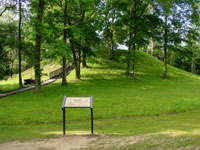How should law enforcement and medical examiner officials respond?
Guide for Law Enforcement Officers, Medical Examiners and Medical Examiner Investigators
Chapter 872, especially Section 872.05, Florida Statutes, contains specific provisions for treatment of unmarked human remains. Information about the statute, and how it is implemented, is found on this web site. If you are unfamiliar with the procedures, you should start at the beginning and review the various sections before proceeding. This specific page lists a few pointers for law enforcement and medical examiner officials who may become involved with unmarked human remains, and their special treatment under the law. 
For federal and tribal lands, the procedures below do not apply to Native American human remains, which are the most common type of unmarked remains. Contact the federal or tribal land manager or agency official to initiate the appropriate procedures called for in federal law. See the section on NAGPRA for additional information.
Section 872.05, Florida Statutes, concerning unmarked human remains requires anyone having knowledge of discovery or disturbance of such remains to contact the local law enforcement agency with jurisdiction. Any officer may enforce the provisions of Chapter 872, but typically such cases end up with Fish and Wildlife Commission and Sheriff's offices more often than municipal police departments, primarily because such discoveries are most often made in wooded or undeveloped areas.
Law enforcement officers responding to possible discovery of human remains should first review the procedures in Section 872.05, Florida Statutes, and should be prepared to coordinate with the District Medical Examiner and the State Archaeologist. If the remains have been buried less than 75 years, or are possibly involved in a criminal investigation, the Medical Examiner has jurisdiction. If the remains have been buried more than 75 years AND are not involved in a criminal investigation, the State Archaeologist has jurisdiction.
The State Archaeologist can be reached at the Florida Division of Historical Resources, Bureau of Archaeological Research, 850.245.6444 or 850.245.6301. Your law enforcement agency probably already has protocols for communication with the Medical Examiner. A list of contact information for all medical examiners in Florida is available here.
Treat a location where human remains are exposed or have been removed as a crime scene. Secure the area with a generous perimeter, and do not leave the area unguarded until the risk of further damage can be established and controlled. Do not remove remains or dig further; this is more appropriately done by an archaeologist or a forensic investigator.
Unmarked human remains may be claimed by someone representing a tribe or cultural group. Do not, under any circumstances, allow anyone to take remains other than persons authorized by the State Archaeologist or the Medical Examiner, whoever has jurisdiction. Procedures are already in place for proper consultation and coordination with family, ethnic or tribal representatives, and these will be followed to determine a proper and legal final disposition of the remains.
Certain organizations in Florida may be helpful in determining whether remains are human and in evaluating cultural and biological characteristics. Such information can be critical in determining an appropriate final disposition. It is recommended that examination of remains by a physical anthropologist (called a skeletal analyst in Section 872.05, Florida Statutes) be arranged by the State Archaeologist or the Medical Examiner, after they have assumed jurisdiction and supervised proper removal of any samples.
Human remains sites are in danger of further disturbance by diggers, collectors, and others; this threat increases as discoveries are publicized. It is recommended that such cases be handled most discreetly and that photographs and video of human remains not be allowed. Keep the public outside the secure area to protect the remains and any evidence that may assist in archaeological or law enforcement investigation.
It can be difficult to determine whether remains have been in the ground less or more than 75 years, and whether the Medical Examiner or State Archaeologist will have jurisdiction. In some cases, depending on the nature of the burial and the experience of the official, archaeological deposits such as shell middens may be easy to recognize by their distinctive soil and artifacts. Most often the initial call is to the Medical Examiner, who may make the call. In any case, the law enforcement officer and the Medical Examiner should coordinate with the State Archaeologist.
Discoveries of human remains are often confusing and potentially volatile. Misinformation, disinformation, and errors spread quickly and a situation can go out of control in a very short time. Hundreds of discoveries have occurred since Section 872.05, Florida Statutes, became law in the 1980s, and the appropriate parties are used to following regular procedures to minimize damage, respect remains, maintain custody, and arrange final disposition. Contact the Medical Examiner and State Archaeologist as soon as the location is secure, and maintain frequent and open communication with whomever has jurisdiction.

